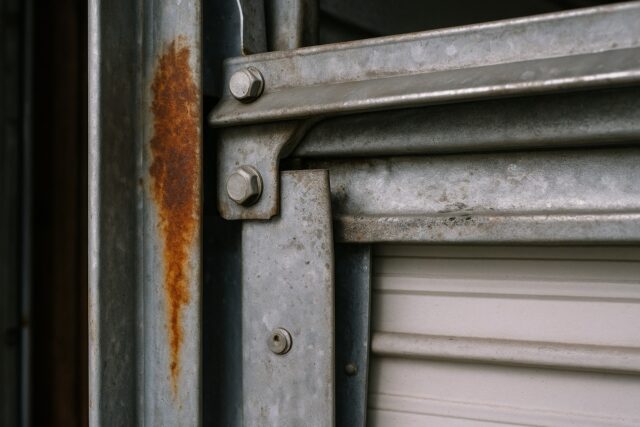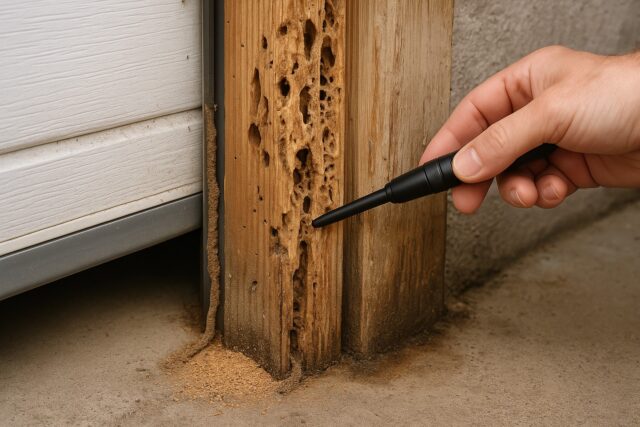When James from Austin contacted Alpine Garage Doors Texas last summer, he was very concerned. His garage door was struggling to close properly. After a thorough examination, our technician discovered the problem was not just the garage door itself but the framing around the garage door opening. Over time, the wooden framing had shifted and weakened due to weather exposure and normal wear. This case demonstrates why a comprehensive garage door framing inspection is crucial for homeowners and business owners alike to ensure the safety, security, and proper function of their garage doors.
Garage doors are among the largest moving parts of a home. The framing around the garage door, including the header and supporting studs, serves as the structural backbone that holds the door in place. If the framing becomes damaged, warped, or improperly installed, it can lead to a variety of issues such as door misalignment, difficulty opening or closing, and even potential safety hazards. According to the National Association of Home Builders, approximately 30 percent of homeowners experience garage door issues caused by improper framing or structural damage within the first ten years of installation. In Austin, where intense heat, occasional heavy rains, and humidity are common, garage door framing problems can develop faster than in milder climates.
Understanding what to include in a garage door framing inspection is essential for maintaining your property’s value and safety. Whether you are a homeowner, a property manager, or a contractor, knowing how to identify issues with the rough opening dimensions, header support, framing materials, and code compliance will help you avoid costly repairs in the future. In this article, we will explore in depth every component and step involved in a garage door framing inspection in Austin, TX. We will discuss how to check the condition of framing materials, how to measure and size headers, what building codes apply, and how to recognize signs of damage or wear. By the end, you will have a clear understanding of how to ensure your garage door frame remains solid and code-compliant for years to come.
Why Is a Garage Door Framing Inspection So Important?
The garage door opening dimensions and framing play a critical role in how well your garage door functions. The framing consists of several key components, including the supporting header, king studs, jack studs, and sill plates that together create the rough opening for the garage door. This opening must be precisely measured and built to withstand the load of the garage door itself, as well as any mechanical components such as springs and openers.
If the framing lacks proper structural support, the door can sag or become misaligned. This not only makes the door difficult to open or close but also poses safety risks. For example, a weakened or improperly sized header may fail under the weight of the door, potentially causing the entire assembly to collapse. Austin’s climate conditions, with high humidity and temperature fluctuations, make moisture-resistant framing materials and proper sealing especially important to prevent wood rot and rust.
A garage door framing inspection identifies any damage or weaknesses in the framing materials. It also ensures that the structure is built according to the local building code for garage door framing. These inspections can prevent future damage and extend the life of your garage door system. With the right inspection and maintenance schedule, you can avoid emergency repairs, reduce energy loss through better insulation and sealing, and improve the overall safety and security of your property.
What Does a Garage Door Framing Inspection Include?
A garage door framing inspection is a detailed process that covers several important elements to verify the strength, alignment, and compliance of the garage door structure. Let’s explore each key part of the inspection and what technicians look for when performing a thorough check of garage door framing in Austin, TX.
1. Visual Inspection of Framing Materials for Garage Openings
The first part of the inspection involves closely examining the framing materials that make up the rough opening. These materials typically include wood or metal studs and engineered lumber headers.
For wood framing materials, inspectors look for signs of moisture damage such as rot, mold, or swelling. Austin’s humid climate can cause untreated wood to deteriorate rapidly if not properly protected. Cracks, splits, or warping in the wood can compromise the structural integrity of the garage door opening. Moisture-resistant framing materials, such as treated lumber or composite materials, can greatly increase the longevity of the frame in Texas weather conditions.
For metal framing materials, inspectors check for corrosion, rust, or bent framing members. Rust weakens the metal and may eventually lead to failure under load. Metal framing also requires regular checks to ensure connections and fasteners remain tight and secure.

Professional contractors use a combination of visual inspection and sometimes moisture meters or other tools to assess the condition of the framing. They also verify if any sections have been previously repaired or replaced and if those repairs meet permitted framing specs and code requirements.
2. Checking for Structural Damage, Warping, and Alignment
The structural support for garage doors depends heavily on the frame maintaining proper shape and alignment. Using tools such as a level, framing square, and straight edge, inspectors carefully measure the frame’s vertical and horizontal alignment. Warping or bowing of framing members, especially the header or king studs, can cause the garage door to bind or become stuck.
Warping also places excessive strain on the garage door tracks and rollers, leading to faster wear and tear of these components. For example, an uneven frame can cause the rollers to derail or the door panels to rub against the frame, creating noisy operation and potential damage.
If the header is bowed or the king studs are twisted, technicians may recommend reinforced framing for garage doors by adding sister studs or installing steel reinforcement plates to restore proper alignment and strength.
3. Inspecting the Supporting Header for Garage Doors
The header is the horizontal beam that spans the top of the garage door opening. It carries the load of the wall above and supports the weight of the garage door, especially in cases of overhead or sectional doors. Choosing the correct size and material for the header is vital to ensure safe, long-lasting garage door operation.
Inspectors verify the header is free of cracks, splits, or signs of rot. In Austin, it is common to see headers made from engineered lumber, which provides superior strength and resistance to warping compared to traditional wood. Engineered lumber headers are often sized according to header span tables that take into account the rough opening width and the load-bearing requirements for the structure.
Proper installation of the header includes secure fastening to the king studs on either side of the opening and ensuring the header itself is level and flush. A load-bearing header that meets building code for garage door framing helps prevent sagging or failure during the door’s operation.
4. Verifying the King Studs and Jack Studs
King studs are the full-length vertical studs on each side of the garage door opening. Jack studs, sometimes called trimmer studs, are shorter vertical supports that help transfer the load from the header down to the foundation or sill plate. These studs must be straight, securely fastened, and free from damage.
The inspector checks that the king and jack studs are correctly positioned according to the garage door framing installation guide and local code-compliant framing standards. Any damage, such as cracks, splits, or pest infestation, can weaken these important load-bearing members and require repair or replacement.
Correct placement and sizing of these studs are critical to maintaining the structural integrity of the garage door opening. Misplaced or undersized studs can lead to uneven stress on the header and garage door tracks.
5. Assessing the Sill Plate and Bottom Framing
The sill plate, or bottom framing member, is the foundation upon which the garage door frame rests. It typically sits directly on the concrete slab or foundation. Inspectors evaluate the sill plate for moisture damage, rot, or pest activity that could cause the entire frame to shift or settle unevenly.
In many cases, moisture can seep through cracks or gaps in the slab or improper drainage around the garage perimeter. Proper sealing and use of treated, moisture-resistant sill plates help protect this critical framing component. Shims and level adjustments may be used during installation to ensure the sill plate is perfectly flat and even.
Damage or movement of the sill plate can result in misaligned garage doors, difficulty in operation, and additional wear on mechanical parts.
6. Checking Fasteners, Connections, and Reinforcements
All framing components are connected by fasteners such as nails, screws, or bolts. Inspectors carefully examine these fasteners for rust, looseness, or missing pieces that could compromise the entire framing assembly.
In addition, some garage door openings may require reinforced framing for garage doors, especially for wider openings or commercial installations. This reinforcement may include metal straps, hurricane ties, or additional studs to meet the higher load requirements specified in the building code.
Proper fastening and reinforcement ensure the frame can handle the dynamic forces involved when the door opens and closes hundreds of times a year.
7. Evaluating Weatherproofing, Insulation, and Sealing Around the Frame
A properly framed garage door opening also includes weatherproofing and insulation to improve energy efficiency and prevent moisture intrusion. Inspectors check for gaps, cracks, or missing weatherstripping around the rough opening that can allow drafts, water, or pests to enter.
Austin’s climate, with hot summers and occasional heavy rain, demands good sealing practices around the garage door frame. The use of foam insulation around the header and studs, quality weatherstripping, and caulking all contribute to maintaining a comfortable garage environment and reducing energy costs.
8. Inspecting for Pest Damage and Moisture Intrusion
Pest damage is a common problem for wooden garage door framing in Texas. Termites, carpenter ants, and other wood-destroying insects can undermine the structural support silently and rapidly.
The inspection includes looking for signs such as hollow-sounding wood, mud tubes, wood dust piles, or visible insect activity. Moisture intrusion creates the perfect environment for these pests, making moisture-resistant framing materials and proper drainage essential preventative measures.

9. Verifying Track Alignment and Opener Mounting Support
The garage door tracks must be perfectly aligned with the frame to allow smooth door operation. Inspectors test track alignment to identify any frame-related causes of door sticking or derailment. Misalignment is often traced back to warped or damaged framing.
Additionally, the mounting points for the garage door opener are usually attached to the header or framing. Inspectors check that these points are secure, level, and free from damage to prevent stress on the opener or door.
10. Reviewing Code Compliance and Permit Specifications
A professional garage door framing inspection in Austin, TX, also includes a review of applicable local building codes and permit specifications. These codes dictate minimum requirements for framing materials, header sizing, load-bearing capacities, and installation practices.
For example, the building code for garage door framing often requires the use of specific engineered lumber headers sized according to the rough opening width and expected load. It also regulates the spacing and size of king studs, jack studs, and the use of proper fasteners.
Ensuring code-compliant framing not only guarantees safety but also facilitates smooth permit approvals for new installations or major repairs.
Tips for Homeowners and Contractors in Austin, TX
- Schedule a professional garage door framing inspection at least once a year, especially after severe weather events.
- Pay attention to signs such as door sticking, misalignment, unusual noises, or visible cracks around the garage door opening.
- Always hire licensed contractors familiar with local building codes and garage door framing installation guides to perform repairs or modifications.
- Maintain good drainage around your garage to prevent moisture buildup around the sill plate and framing.
- Use moisture-resistant framing materials and seal all gaps to extend the life of your garage door frame in Austin’s climate.
Signs You Need a Garage Door Framing Inspection
If you notice any of the following signs, it is important to schedule a garage door framing inspection immediately:
- The garage door does not open or close smoothly
- The door appears misaligned or sags in the middle
- Loud banging, grinding, or scraping noises during operation
- Visible cracks, gaps, or rot in the framing around the opening
- Mold or moisture stains near the header or sill plate
- Evidence of pests such as termites near the garage door frame
- Your property has not had a professional framing inspection in several years
Frequently Asked Questions (FAQs)
- How often should I replace the header in my garage door frame?
Headers typically last for many years if properly maintained, but signs such as visible cracks, sagging, or water damage indicate it may need replacement. It is best to have a professional inspect the header every few years or after severe weather events. - Can I upgrade my garage door frame to support a heavier door?
Yes, upgrading to an engineered lumber header or adding reinforced framing can support heavier garage doors, such as insulated or custom models. A professional contractor can assess your current frame and recommend the necessary modifications. - What is the difference between king studs and jack studs in garage door framing?
King studs run the full height of the wall and provide main vertical support on either side of the opening, while jack studs are shorter and support the header by transferring its load to the foundation. Both are essential for structural stability. - Are there any special permits required for garage door framing changes in Austin, TX?
Yes, major modifications to garage door framing typically require permits to ensure compliance with local building codes. It is important to consult your local building department or a licensed contractor before starting work.
How Can Alpine Garage Doors Texas Help You?
At Alpine Garage Doors Texas, we understand how critical a properly framed garage door opening is to your home or business. Serving Austin, Houston, and the surrounding areas, our trained technicians specialize in comprehensive garage door framing inspections and repairs for both residential and commercial properties.
We offer:
- In-depth garage door framing inspections that cover every critical component, including headers, king studs, jack studs, sill plates, and fasteners
- Expert repairs and reinforcement using code-compliant framing materials such as engineered lumber headers and treated moisture-resistant wood
- Custom garage door framing installations following local building codes and permit specifications
- Maintenance services designed to prolong the life of your garage door system and prevent future framing problems
- Fast, reliable service with a focus on customer satisfaction and quality workmanship
If you see any signs of framing damage or simply want peace of mind that your garage door frame is structurally sound, call us at 346-438-1138 or visit us at 638 Saddle Rock Dr, Houston, TX 77037. Contact us today. Let our experts ensure your garage door operates safely and efficiently year-round.
Final Thoughts
The framing around your garage door opening is a vital structural element that affects the safety, security, and functionality of your garage door. A thorough garage door framing inspection in Austin, TX, includes checking framing materials for damage, verifying proper header sizing and support, ensuring alignment and level installation, and confirming compliance with local building codes. It also involves inspecting for moisture intrusion, pest damage, and proper weatherproofing to protect your investment.
By understanding these key components and scheduling regular inspections, you can prevent costly repairs, improve your garage door’s performance, and maintain the value of your home or business. Always work with experienced contractors who follow garage door framing installation guides and use quality materials to ensure a durable and code-compliant frame.
Alpine Garage Doors Texas is here to help you every step of the way with trusted garage door framing inspections, repairs, and installations. Protect your property and your peace of mind by contacting us today for expert service tailored to your needs.

